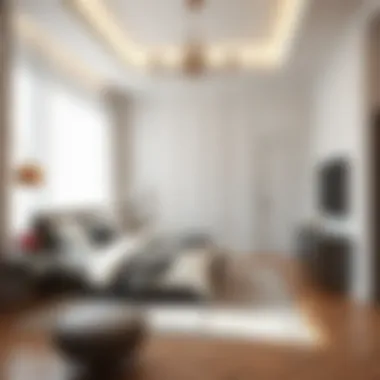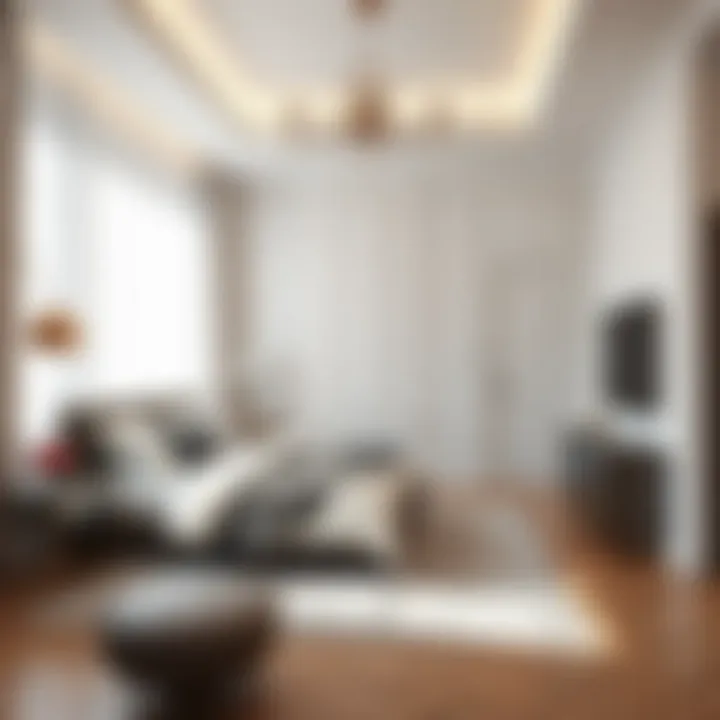Exploring Bedroom Arrangement Simulators for Optimal Design


Intro
In the world of interior design, the layout of a bedroom can make or break its overall appeal and functionality. With the rise of technology, bedroom arrangement simulators have emerged as practical tools, enabling both homeowners and professionals to visualize their spaces in a way that was nearly impossible just a decade ago. These digital platforms allow users to experiment with various layouts, styles, and furnishings, creating an interactive experience that offers both creativity and practicality.
Using a bedroom arrangement simulator is not simply about placing a bed here or a dresser there. It is about understanding how these elements interact with each other and the flow of the room overall. Whether you're a housewife looking to enhance your living space for comfort or a homeowner wanting to optimize your bedroom's functionality, knowing how these simulators work can lead to profound improvements in your personal well-being and efficiency.
Additionally, in today’s fast-paced world, many people find themselves overwhelmed by design options. Luckily, these simulators provide a structured format within which individuals can explore design styles, color palettes, and furniture layouts tailored to their individual tastes and requirements. As we dive deeper into this fascinating topic, we will uncover the various trendy styles, effective color combinations, and the software options available that make designing your dream bedroom more accessible than ever.
Get ready to transform the way you think about your bedroom space!
Foreword to Bedroom Arrangement Simulators
In today's fast-paced world, the design of our living spaces has gained unprecedented significance. The bedroom, often considered a personal sanctuary, requires special attention when it comes to layout and aesthetics. Bedroom arrangement simulators serve as digital tools tailored to help homeowners visualize and optimize their bedroom designs. With these simulators, individuals can meticulously plan every square foot, ensuring their space is not only functional but also aesthetically pleasing.
Definition and Purpose
To put it simply, a bedroom arrangement simulator is a computer software or mobile app that allows users to create virtual layouts of their rooms. These simulators take a three-dimensional approach, providing a more accurate representation compared to basic 2D plans. The primary purpose is to enable users to experiment with different layouts and furnishings, offering a hassle-free way to see how changes can affect the overall vibe of the room.
For instance, one could position a bed against a window or try a different orientation without heavy lifting. The underlying aim is to empower users to make informed decisions about their living spaces, enhancing not only the functionality but also the comfort of their bedrooms. These simulators often include features such as drag-and-drop furniture, variable dimensions, and even color palettes to help individuals envision their perfect escape.
Historical Context
The concept of using simulated environments for design isn’t new. Early forms can be traced back to the early 20th century when architects used scale models to illustrate their ideas. However, it wasn’t until the 1990s that technology took a leap forward with the introduction of computer-aided design (CAD) software. Back then, only professionals could afford or access such expensive tools. It paved the way for what we now know as bedroom arrangement simulators.
In the years that followed, the proliferation of personal computers and advancements in graphics technology opened the floodgates. More accessible tools emerged, thus allowing not just designers but also everyday homeowners to experiment with their spaces. As a result, these simulators have democratized interior design, bridging the gap between professional expertise and layman curiosity. The historical evolution reflects the growing recognition of the importance of personalized living spaces, underscoring a shift in societal values toward self-expression in home design.
End
In summary, bedroom arrangement simulators stand at the crossroads of technology and personal design. They blend historical practices with modern needs, calling to action anyone looking to enhance their personal space. Embracing these tools can lead to more thoughtfully arranged, functional, and inviting bedrooms.
Technological Advancements in Interior Design
With the way our world spins these days, the realm of interior design is being deeply affected by new technologies. Bedroom arrangement simulators are one incredible example of how rapid advancements in tech can turn a simple task into something dynamic and engaging. The intersection of technology and design is not just about aesthetics; it’s about enhancing functionality, user experience, and even emotional well-being. In this section, we’ll delve into the pivotal role that technology plays in bedroom design, focusing on software evolution and the brainy flair of augmented reality.
Evolution of Design Software
Let’s travel back in time for a moment. Not too long ago, interior designers relied heavily on hand-drawn sketches and physically moving furniture around to figure out the best layout for a space. It was laborious and often turned into a game of trial and error. Fast forward to the present, where design software has almost become indispensable.
These programs have advanced by leaps and bounds, allowing users to create detailed and accurate representations of their bedrooms faster and more effectively. Users can manipulate dimensions, choose materials, and even visualize how the layout feels. Popular platforms such as SketchUp and AutoCAD have not only improved in their functionality but have also made complex design concepts accessible to the everyday homeowner.
The ability to produce virtual 3D models of bedrooms means users can see designs come to life on screen. This is invaluable for those who may not possess a design background but have a vision. A point to underscore here is that software evolution doesn’t just appeal to seasoned professionals; it opens doors for all homeowners by leveling the playing field. Here, art and science shake hands.
In this digital age, we see users tapping into community platforms, exchanging ideas and inspirations. From forums on Reddit discussing tips and tricks, to watching YouTube tutorials that breakdown software functionalities, there's a wealth of information available. This ties back to the beauty of technology: it fosters collaboration and encourages creativity.
Integration of Augmented Reality
Pop quiz: What’s cooler than drawing a bedroom layout on a computer? Being able to walk around in it! Enter Augmented Reality, or AR, which sprinkles a little magic dust on the whole design process. Instead of merely visualizing a design through a screen, AR allows homeowners to merge the virtual with the real. Simply point your smartphone at your empty bedroom, and voilà! You can see how that sleek dresser or chic bedside table looks in the actual space.
This technology takes intuition up a notch; no longer do you have to guess if the new bed frame will really fit. You can see, right there in the moment, how everything interacts with the existing space. For visual learners and those who need to directly interact with their environment, augmented reality is a game changer, helping avoid the misstep of purchasing items that just aren’t a good fit.
Furthermore, AR can provide contextual cues that enhance decision-making. Want to see how various color schemes play off natural light in your room? AR can show you the impact, allowing you to consider how your daily life interacts with your chosen decor.
“Designing a bedroom becomes not just about choosing colors or furniture but about experiencing how those choices fit into your life.”
In wrapping up this section, the technological advancements in interior design highlight how integral these tools have become in crafting spaces that not only look good but work well for individuals. These innovations cater to diverse needs, ensuring that the art of bedroom design is fully realized through both creativity and technology.
Benefits of Using a Bedroom Arrangement Simulator


The rise of bedroom arrangement simulators has revolutionized the way individuals approach the design and optimization of their living spaces. With technology continuing to advance at a brisk pace, these digital tools offer a myriad of benefits that cater to both professional designers and everyday homeowners. Understanding these advantages is crucial, as they can directly influence the efficiency, aesthetics, and overall satisfaction one gains from their personal sanctuary.
Enhanced Spatial Planning
One of the most notable advantages of employing a bedroom arrangement simulator is its capacity for enhanced spatial planning. These simulators allow users to visualize how various elements will fit within a room. Homeowners can experiment with different layouts without the hassle of manual measurements and heavy lifting, essentially circumventing many of the trial-and-error pitfalls inherent in traditional design methods.
Imagine a scenario where you want to rearrange your bedroom to accommodate a new queen-sized bed alongside a desk for remote work. A simulator can help you understand potential layouts. Users can drag and drop furniture to see how much space remains, ensuring movement is still fluid and functional.
- Visually Experimentative: This technology creates a 3D view of your room, offering a realistic feel of how furniture and decor might interact with one another.
- Scale and Proportion: It aids in grasping the scale and proportion of furniture pieces in relation to the room size, which is difficult to ascertain through imagination alone.
- Multiple Configurations: Users can effortlessly switch between different designs in a matter of clicks, refining the layout until they find the sweet spot that resonates with their vision.
Cost Efficiency in Home Design
Another significant benefit of using these simulators is their role in promoting cost efficiency in home design. Traditional interior design projects often incur expenses not only related to materials and furnishings but also to consultation fees. By utilizing a bedroom arrangement simulator, homeowners can effectively save money in several key ways.
- No Need for Design Professionals: Many find that they do not require external designers to create a functional layout, allowing families to keep that budget for other vital areas, such as materials or personal touches.
- Reduced Mistakes: By visualizing designs before committing, the likelihood of purchasing erroneous items that won’t fit or that do not coordinate diminishes significantly.
- Smart Shopping: Often, these simulators can suggest where to buy the furniture or decor based on the designed layout, highlighting sales or discounts. Users can plan their purchases strategically, stretching their budgets further.
Improved User Engagement
Lastly, engaging with bedroom arrangement simulators cultivates a more hands-on approach to personal space modification. Homeowners are no longer passive receivers of design ideas imposed by others but are empowered to craft their personal environments according to their individual tastes and lifestyles.
- Interactive Design Process: With drag-and-drop functionality, users can actively shape their space as though they were movers in their own home, which adds a layer of enjoyment to the planning process.
- Learning Curve: As users become adept at using these tools, they often expand their understanding of interior design principles, which can have long-term implications for future decorating and remodeling projects.
- Sense of Accomplishment: There’s a certain satisfaction that comes from watching a digital representation of one’s dream bedroom come to life, enhancing the emotional connection to the space and providing motivation to implement those designs in reality.
"Using bedroom arrangement simulators doesn't just save time and money; it transforms the very essence of how we interact with our personal spaces."
Integrating these simulators into one’s home design strategy can yield profound benefits, turning the often daunting task of bedroom layout into an enlightening and enjoyable journey. Whether it's about spatial optimization, cost-effectiveness, or nurturing engagement, the investment in learning how to use these tools can lead to a more satisfying living environment.
Popular Bedroom Arrangement Simulators
In recent years, bedroom arrangement simulators have gained traction among homeowners and interior design enthusiasts alike. These tools allow users to visualize furniture layouts and optimize spaces without the hefty price tag associated with traditional design services. By utilizing bedroom arrangement simulators, individuals can create inviting and functional environments tailored to their specific needs.
This section dives into the practical aspects of the most popular simulators available, examining how they serve as a vital resource for effective space planning.
Software Overview
The landscape of bedroom arrangement simulators is diverse, with various software solutions offering unique features and capabilities. Among the most noted ones is Roomstyler, known for its user-friendly interface. It allows users to drag and drop furniture items into a virtual room while providing an accurate sense of scale. Other contenders include SketchUp, favored by professionals for its versatility and customization options, and Planner 5D, which caters to both novice homeowners and expert designers with its intuitive design features.
These simulators not only help visualize spaces but also encourage trial and error in the design process. It's akin to having a canvas where one can sketch out their dreams without the fear of making irreversible decisions.
Key Features and Functionalities
When evaluating bedroom arrangement simulators, several key features stand out that enhance user experience and functionality:
- 3D Visualization: The ability to see a design in three dimensions brings clarity to spatial dynamics, allowing users to assess how well their choices work together.
- Drag and Drop Interface: This aspect simplifies the design process. Users can quickly position furniture and decor in a practical manner—saving time and reducing frustration.
- Customizable Elements: Many simulators provide options to adjust dimensions, colors, and styles to reflect personal tastes, making the digital room a true representation of one’s vision.
- Integration of Real-World Products: Some tools partner with furniture retailers, enabling users to select actual items for their layouts. This way, not only can they dream but also bring their designs to life with tangible products.
- Cross-Platform Compatibility: Being able to access the simulator on multiple devices—be it smartphone, tablet, or desktop—enhances usability, ensuring that design can happen at home or on the go.
"A good home is a place where every piece of furniture tells a story and every color gives a feeling."
In summary, popular bedroom arrangement simulators provide a valuable bridge between imagination and functionality in design. They empower users to embrace their creativity while making informed decisions about their spaces.
Effective Usage of Bedroom Arrangement Simulators
Using bedroom arrangement simulators effectively can be the difference between a frustrating design process and creating a harmonious space that reflects your personal style. In this section, we will look at how to maximize the potential of these tools, the benefits they offer, and some key considerations to keep in mind as you navigate your bedroom layout.
Step-by-Step Guide to Designing
Designing your bedroom with a simulator is not just about clicking and dragging furniture icons around a digital canvas; it's about crafting a livable sanctuary tailored to your needs. Here’s a straightforward guide to help you get started:
- Assess Your Space: Measure the dimensions of your bedroom carefully. Note the features you cannot change, like windows, doors, and built-in wardrobes.
- Choose Your Simulator: Select a simulator that fits your skill level. Some popular options are SketchUp, Roomstyler, and Homestyler, each offering unique features.
- Input Dimensions: Input the measurements of your room into the simulator. This step ensures that your virtual design mirrors your actual space. A miscalculation here can lead to big headaches down the line.
- Start with Basics: Begin by placing essential furniture—bed, nightstands, and dressers. This foundational step helps you visualize how the space flows and functions.
- Experiment with Layouts: Don’t be afraid to move things around. A simulator allows for quick adjustments without the heavy lifting. Try different configurations to see what works best.
- Add Details: Include smaller elements next, like lamps and art. These details can greatly affect the mood of the room, so take your time to choose wisely. The atmosphere should resonate with your personality.
- Visualize Colors and Textures: Many simulators allow you to apply different designs and materials. Test out various color palettes and cloth textures to see how they influence the overall vibe.
- Seek Feedback: Share your design with family or friends. Sometimes a fresh pair of eyes can spot something you may have overlooked or provide valuable insights.
- Finalize and Deploy: Once you feel confident in your design, create a list of items you need to purchase and any changes you might need to make in your sleeping space.


Common Mistakes to Avoid
While using a bedroom arrangement simulator can simplify your design process, there are still pitfalls that can trip you up. Here are some common mistakes to steer clear of:
- Ignoring Scale: A rookie error is placing furniture that looks good on-screen but won't actually fit in the physical space. Always refer back to your measurements.
- Overcrowding the Room: A well-decorated bedroom is not one that is stuffed to the brim with furniture. Make sure there’s enough space to move around; nobody wants to feel cramped.
- Neglecting Lighting: Often, the importance of natural and artificial lighting is overlooked. Assess how light travels through your space at different times of the day and adjust your designs accordingly.
- Lack of Functionality: Design is not just about aesthetics; functionality should be at the forefront. Ensure that your bedroom serves not only as a restful retreat but also meets everyday needs.
- Disregarding Personal Style: Lastly, your bedroom should reflect who you are. Don’t fall into the trap of following trends that don’t speak to you; find what makes you feel at home.
The knowledge of what works and what to avoid can be the cornerstones of achieving a stunning bedroom design that marries beauty and practicality. By keeping these tips at the forefront, you will be well on your way to creating a smart, visually appealing bedroom layout that meets all your needs.
Challenges of Using Bedroom Arrangement Simulators
Engaging with bedroom arrangement simulators comes with a special set of challenges that can shape a user’s experience and results. Recognizing these challenges is crucial not only for homeowners but also for design enthusiasts seeking to optimize their living spaces. It helps them to navigate the practical aspects of design tools and understand their limitations in achieving the desired aesthetic and functional outcomes.
Understanding Limitations
While bedroom arrangement simulators are wonderful tools, they do have their limitations, and knowing them is half the battle. One significant limitation is the accuracy of spatial representation. Often, the virtual space may not align perfectly with the physical dimensions of a room. Users might find that an arrangement that seemingly fits in the simulation feels cramped or awkward in real life.
Another common snag is the unavoidable learning curve associated with different software. Not everyone is tech-savvy, and some might find certain platforms overly complex or unintuitive. This can lead to frustration, ultimately deterring users from fully benefiting from what the software can offer. Furthermore, the equipment used also plays a role; for instance, a basic laptop might not support the software's best features, resulting in a less enjoyable experience.
"Understanding the limitations of bedroom arrangement simulators empowers users to approach their space planning with a realistic outlook."
A significant aspect of this limitation discussion is the reliance on pre-set templates and furniture models, which do not represent the unique character of every user’s belongings. Individuals aiming for a distinct personal touch may find these resources lacking, as they can't accurately portray their curated decor or heirloom pieces.
User Experience Considerations
User experience is paramount when dealing with bedroom arrangement simulators. A smooth interface and intuitive navigation are essential. If the user interface feels clunky or counterintuitive, it can lead to user frustration and a lack of motivation to explore the design process. A carefully designed simulator should encourage exploration and creativity.
Moreover, it’s important to consider accessibility. Many users may have different levels of physical and cognitive abilities. It should be user-friendly enough for a range of audiences, from seasoned designers to everyday homeowners looking to create a cozy nest.
In addition, the reality of technical glitches cannot be ignored. The unexpected crashes or slow response times can derail a user's creative flow, making it crucial for developers to keep their platforms as stable as possible. Integrating a support system or tutorial resources increases the chances of users feeling confident as they navigate the tool.
Additionally, it’s valuable for users to test drive different simulators before settling on one. Because not all simulators fit every user’s needs, familiarity with their unique preferences will help in selecting the best tool for their specific requirements.
In summary, while the advantages of bedroom arrangement simulators are numerous, the challenges they present must be recognized and understood. Navigating these hurdles can lead to more effective design outcomes and a more enjoyable design journey.
The Role of Color and Texture in Bedroom Design
Color and texture play a pivotal role in shaping the atmosphere and functionality of a bedroom. When one thinks of a bedroom, it is not merely a place to sleep; it embodies comfort, relaxation, and personal expression. The hues that adorn the walls and the textiles that blanket the bed can significantly influence one’s mood and even sleep quality. Hence, understanding the dynamics of color and texture is fundamental when utilizing bedroom arrangement simulators. These tools enable users to experiment with various color palettes and fabric choices to craft the ideal sanctuary.
Psychology of Colors
The psychology of colors delves into how different shades affect our feelings and behaviors. Each color resonates differently, carrying unique meanings and emotional triggers. For instance, blues often promote calmness and serenity, making them a popular choice for bedrooms. A soft blue or teal might create a peaceful environment conducive to rest. Alternatively, warmer tones like reds and oranges could energize the space, but their intensity may not be ideal for sleep.
When using simulators, it becomes possible to visualize how a chosen color will interact with other elements in the room. This can be particularly beneficial when considering how light plays into a color’s appearance at different times of day.
- Cool Colors: Often associated with tranquility, think soft greens or lavenders. They can make a small space feel larger and more open.
- Warm Colors: These promote a sense of coziness; shades like mustard yellow or deep maroon may incite feelings of warmth and comfort, albeit excessive use might overwhelm the senses.
Starting a design process with a clear understanding of color can truly set the stage for the desired feel in the bedroom. When house owners experiment with these colors in bedroom arrangement simulators, they can easily adjust and assess which combinations evoke the intended emotional response.
Texture Variations and Their Effects
Texture is equally crucial in bedroom design, as it adds depth and character to the space. The combination of various textures can create a more inviting atmosphere. A plush throw on a sleek bedspread or a woven rug underfoot can harmonize contrasting elements to make the space uniquely yours.
- Soft Textiles: Fabrics like velvet or cotton can offer luxurious comfort, inviting you to sink into the bedding after a long day. A fluffy duvet might emotionally soothe after you’ve been on your feet, creating a supple environment for relaxation.
- Natural Elements: Incorporating materials like wood and stone can ground the room, providing an earthy feel that brings the outdoors in. Such textures may make the bedroom feel more serene, blurring the lines between the natural world and your private sanctuary.
In a bedroom arrangement simulator, users can experiment with texture while swapping out various elements. For instance, one might visualize how a certain fabric swatch looks against a wall color or how a rug interacts with the floor design. The tactile response generated by these textures can significantly impact overall comfort, making each person’s sanctuary feel both personalized and functional.
"The right colors and textures can transform a plain room into a personal haven that resonates with peace and joy."


Incorporating Wellness Trends into Bedroom Design
In recent years, the concept of wellness has seeped into various aspects of life, including how we design our living spaces. When we incorporate wellness trends into bedroom design, we aren't just rearranging furniture; we’re creating environments that nurture mental and physical health. This integration of wellness into design focuses on various elements like mindfulness, natural elements, and effective use of space to foster an atmosphere of tranquility and balance.
Mindfulness Practices in Bedroom Layout
The art of mindfulness can profoundly influence bedroom layouts. The core idea of mindfulness is to cultivate an awareness of the present and to create spaces that promote this principle. Here are some key considerations when approaching a mindful bedroom design:
- Simplicity and Minimalism: Keeping things minimal can reduce clutter, which in turn reduces stress. A few select items can evoke calm rather than chaos.
- Intentional Arrangement: Placing furniture thoughtfully enhances movement and flow, allowing easy navigation (think about pathways and the vibe each part of the room conveys).
- Personal Touch: Incorporating personal items that bring joy or inspire peaceful thoughts can make the space feel uplifting and stress-free.
Utilizing techniques like these promotes a serene environment conducive to relaxation and deeper rest. Mindfulness practices not only enhance aesthetics but also increase the overall functionality of the space.
"A well-placed piece of art or a beloved book can ground the room, making a significant impact on emotional well-being."
Natural Elements and Biophilic Design
Biophilic design is another facet of wellness that emphasizes the connection between nature and human life. By integrating natural elements into bedroom design, you tap into the calming effects of nature. Here are a few strategies to consider:
- Natural Light: Maximize natural light by using light, airy curtains or keeping windows unobstructed. Natural sunlight boosts mood and regulates circadian rhythms.
- Earthy Colors: Using colors inspired by nature—like soft greens, blues, and browns—creates a soothing palette. These colors are pleasing to the eye and help maintain balance and relaxation in the room.
- Indoor Plants: Bringing plants into the bedroom not only improves air quality but also adds life and vitality to the space. Plants like snake plants or peace lilies are both beautiful and beneficial.
By making these changes, the design of the bedroom becomes an extension of nature itself, creating an environment that promotes health and wellness. Biophilic elements can transform your sanctuary into a place that feels as refreshing as a walk in the woods.
Incorporating wellness trends into bedroom design isn’t just a passing fad; it’s a vital part of creating a space that supports your overall well-being. As housewives and homeowners look to enhance their living areas, focusing on wellness can elevate a simple bedroom into a haven where one can unwind and recharge.
Impact on Personal Well-Being
A well-arranged bedroom can work wonders for a person’s mental and physical well-being. The way we design and organize our personal spaces can lead to significant improvements in our quality of life. This section digs into the specifics of how a thoughtfully designed bedroom does not merely serve aesthetic purposes; it creates an environment that fosters relaxation and recharges our spirits. Understanding how space affects our mood and health is critical—especially for housewives and homeowners who spend considerable time in their homes.
Psychological Benefits of a Well-Designed Space
The arrangement of furniture, the color of the walls, and even the placement of personal items can have a profound psychological impact. It’s often said that environment shapes behavior, and this holds particularly true when it comes to our living spaces.
First off, a decluttered space promotes a clear mind. Studies have shown that excessive clutter can increase feelings of anxiety and stress. When you walk into a bedroom that is organized and harmonious, it invites calmness and peace.
- Calming Colors: Colors can evoke specific feelings. Soft hues like blues and greens are known to soothe the mind, while brights such as yellows can energize. Selecting the right palette affects not just the look of the room but also your emotional state.
- Personal Touch: Items that hold sentimental value can boost happiness. Displaying family photos or cherished mementos can remind you of positive experiences, creating a warm and inviting atmosphere.
Moreover, research indicates that well-designed spaces can enhance productivity. For instance, if the bedroom doubles as an office, a clear distinction between work and sleeping areas can help in maintaining focus, while also making it easier to wind down after work hours. A bedroom that encourages rest and recovery leads to improved mood and performance during the day.
Physical Health Considerations
While the psychological aspects of bedroom design are certainly compelling, physical health is equally critical. A bedroom is more than a resting place; it's a sanctuary for bodily restoration. Understanding how layout and design influence physical wellness can help homeowners create a space that's not just beautiful, but also beneficial.
- Proper Ergonomics: The arrangement of furniture is vital. A well-placed bed can alleviate back pain, especially if it's at the right height and firmness. Likewise, night tables that are at hand’s reach can reduce strain during nighttime.
- Fresh Air Flow: Ventilation plays a crucial role in physical health. A well-placed window allows for a flow of fresh air, which is essential for maintaining energy levels and encouraging restful sleep.
- Natural Light: Exposure to natural light during the day leads to better sleep at night. Arranging your room to maximize sunlight intake can help regulate natural sleep patterns.
Incorporating these elements not only helps alleviate physical discomfort but also enhances sleep quality. A good night’s rest is foundational to overall health, boosting immunity and enhancing mood.
"Creating spaces that nurture both mind and body is essential for holistic well-being. Every little tweak can lead to a significant enhancement in life quality."
The End
The concluding section of this article serves to underline the substantial role that bedroom arrangement simulators play in modern interior design. These tools empower users—be they seasoned decorators or homeowners looking to refresh their living spaces—to make informed decisions about layout, aesthetics, and functionality. As we have explored, the blend of technology and design principles transforms not only how spaces look, but also how they function for daily living.
Summary of Key Insights
In summarizing the key insights gleaned throughout this exploration, several themes emerge:
- Enhanced Spatial Planning: Bedroom arrangement simulators enable individuals to visualize their spaces accurately, helping to maximize functionality and flow.
- Cost Efficiency: By allowing users to experiment with different furniture arrangements and decor before committing to purchases, simulators save time and money.
- User Engagement: With interactive features, these tools draw users into the design process, fostering a sense of ownership and satisfaction with the end result.
Further, we underscored how these simulators can significantly impact a person's well-being by creating environments that cater to both psychological comfort and physical health aspects.
Future Developments in Bedroom Design
Looking ahead, the trajectory of bedroom design will likely be influenced by ongoing technological advancements. As augmented reality becomes more mainstream, we can expect simulators to evolve with features that allow users to superimpose digital elements into their physical spaces in real time. This may lead to:
- Increased Customization: Users could expect personalized design elements tailored to their tastes, all integrated within one platform.
- Collaboration Capabilities: The possibility of sharing designs with family members or interior designers in real-time could enhance collaborative planning experiences.
- Intelligent Recommendations: Future simulators may harness AI to offer suggestions based on user preferences, trending design styles, or even the latest scientific research on wellness in home environments.















